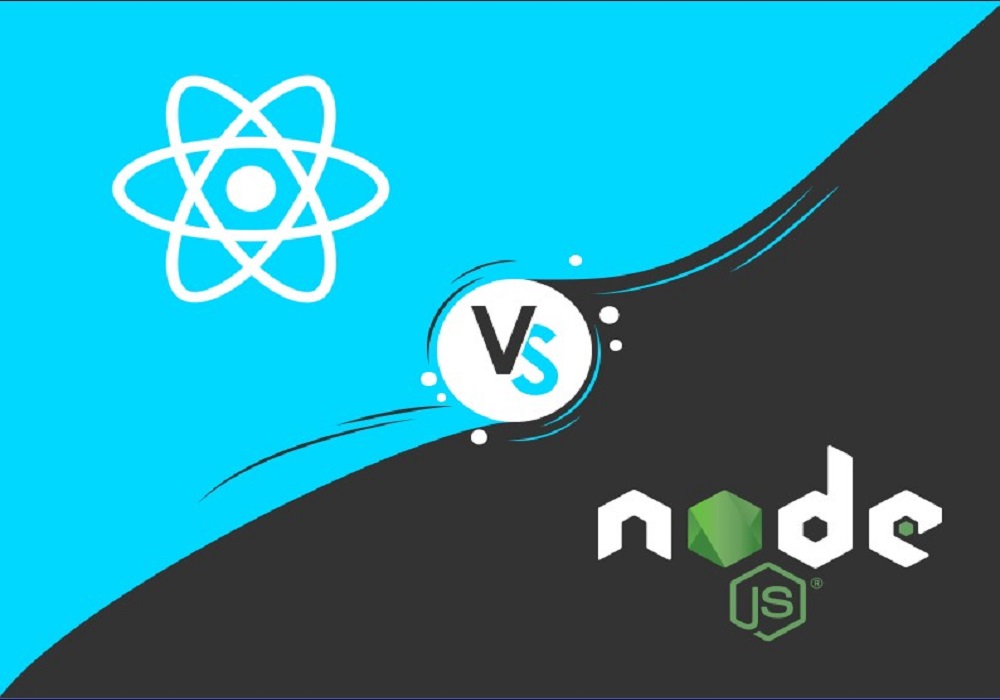Software development for the creation of various digital products like mobile applications, web applications, websites, etc., is becoming essential and necessary nowadays. With time, multiple industries are entering the domain of mobile app development. This development procedure includes different types of mobile apps, web apps, and hybrid mobile applications. No matter what type of application one is looking forward to developing, it still needs the development of software programs. In this article, we will highlight two technologies that are widely utilized in the development of web applications. In addition to learning Node js vs React, we will also review their features and other relevant topics separately.
What Is Node.js?
First things first, let’s discuss what Node JS is. By definition, Node JS is defined as an open-source, runtime, server-side environment. The framework utilizes the JavaScript programming language in order to carry out the task of back-end development of functional web applications. Node.js is also known to support cross-platform deployment.
Web development is known to undergo rapid technological advancement over time. Node.js is utilized by many developers because of its feasibility since it primarily receives data from the client and updates, deletes, or adds data as needed. Node.js provides a response to the client after completing the specific job; due to this time-efficient and effective feature, Node.js is preferred by many developers out there.
What Is React.js?
The second definition that we will discuss is React’s definition. It is known as an open-source Javascript library and framework. Unlike Node.js, this developmental framework is used to create the User Interface (UI) element of web applications.
This JavaScript-based framework was developed by Facebook in May 2013. Since then, it has been used by developers all over the world because of its availability of different elements and features helpful for creating interactive UIs.
What Are Node JS Key Features?
Since there are so many features and points included in the definition alone, it is essential to understand these features in depth. Some of Node JS key features include
- Single-Threaded Working.
- JavaScript.
- Scalability.
- Minimum Buffering.
- Compatible With Multiple Platforms.
- Quick Data Streaming.
- Single-Threaded Working
The first feature of Node JS is its working nature, as the developmental firework utilizes a single-threaded working nature. With the help of this feature, the procedures carried out in the framework are done within a single thread. In other words, from receiving a request to performing the task and then notifying the client, Node.js does it all in one go. This way, the time spent switching the content and reloading is reduced, making task completion efficient.
- JavaScript
As we all know, Node.js utilizes one of the most popular programming languages in the world, JavaScript. This feature adds a lot of benefits, as the majority of programmers already have an understanding of JavaScript. Because of this, Node.js is simple to comprehend and learn.
- Scalability
Node JS key features also include the framework’s ability to support scalability when it comes to developing web applications. Businesses nowadays often look for technologies that they can easily scale up or down depending on their needs. With Node.js, this element is easily controlled as it gives clients the space for constant upgrades.
- Minimum Buffering
Minimum buffering is yet another helpful feature of Node JS. Due to the fact that Node.js uses data streams that include data chunking, there is no or very little data buffering when the framework is employed.
- Compatible With Multiple Platforms
As discussed earlier, one of Node JS key features includes being compatible with cross-platform deployment. In other words, this feature enables users with different operating systems to have access to the web application.
- Quick Data Streaming
Last but not least, quick data streaming is also a beneficial and prominent feature of Node JS. The framework is known to utilize the V8 JavaScript runtime environment. Chrome also makes use of this runtime engine. Because of this, Node.js’s operation speeds up increasingly, as well as enabling incredibly quick data streaming for a web application.
You May Also Read: Getting Started With Sentiment Analysis In Python
What Are React.js Main Features?
After exploring the Node JS key features, we will move forward with understanding the main features of React.js. Some of them are mentioned in the list below.
- Virtual DOM.
- Performance Speed.
- One-Way Data Binding.
- Components.
- Simplicity.
- Virtual DOM
The first feature of React JS is known as the Virtual DOM. Normally, DOM is known as the abbreviated form of Document Object Model. It is an essential component of the web because it is known to separate it into modules and run the code.
Unlike React.js, other frameworks typically update the entire DOM all at once, which slows down the speed of the system. React, however, makes use of virtual DOM, which is a duplicate of actual DOM. In this type of editing procedure, the virtual DOM is initially updated whenever there is a change to the web application. After that, the difference between the real DOM and the virtual DOM is observed. In the last step, the updates are made only where they are required in the original DOM without affecting the speed.
- Performance Speed
Linked to the point mentioned above, the performance speed of React JS is pretty fast compared to other frameworks. The reason for this is that React.js created separate components with the help of a virtual DOM and updated only the ones that were required instead of upgrading the whole DOM, which would require more time and loading speed.
- One-Way Data Binding
The third of React.js’ main features is its one-way binding. The feature allows data to flow in a single direction, known as top to bottom. In other words, the data flows from the parent component to the child components only and can not be reversed. This way, the framework assures a systematic working module.
- Components
Another feature of React JS is its component-based design. With the help of this feature, React.js breaks the website into many components. This allows each element of the user interface to have its own logic and design. Therefore, the component feature expressed in JavaScript makes it simple, runs quicker, and can be reused.
- Simplicity
Last but not least, the React.js framework promotes simplicity and user-friendliness for developers. With the help of code reusability, the division of components, and the JSX feature (a combination of HTML and JavaScript), developers find it easier to develop codes, debug them, or update them effectively.
Node JS Vs. React JS Comparison – Analyzing The Difference Between Both Technologies
In this section of the article, we will review some of the Node JS vs React differences.
- Difference Between Nature.
- Different Between Benefits.
- Difference Between Challenges.
- Difference Between Use Cases.
- Difference Between Learning Curve.
- Difference Between Nature
The first difference between NodeJS and React lies in the nature or purpose of usage. Node.js is known as an open-source server-side JavaScript library that is used for the back-end development of web applications. On the other hand, React is known as an open-source, client-side Javascript library known to create interactive and appealing User Interfaces for applications.
- Different Between Benefits
The second difference lies in the advantages of both frameworks. Node JS is known to be beneficial for its high extensibility, horizontal and vertical scalability, cross-platform compatibility, etc. In comparison, React includes the benefits of component division, faster debugging of codes, code-reusability, Virtual DOM, etc.
- Difference Between Challenges
Just like benefits, both Node JS vs React are also different in terms of the challenges or disadvantages they hold. Developers working with Node JS often report the disadvantage of having limited library options. Meanwhile, developers who use React report having difficulty keeping up with the new releases, versions, and trends.
- Difference Between Use Cases
Since the purpose or objective behind the usage of both frameworks is different, they are also utilized for different purposes in terms of use cases. Node JS is used in data streaming, API services, and microservices. On the other hand, React JS is known to be used for creating dynamic applications as well as web applications with complex structures.
- Difference Between The Learning Curve
Both Node JS vs React are known to be user-friendly and easy-to-learn frameworks. However, there is still a difference in the learning curve for developers. As compared to Node JS, React is easier to learn and implement for developers.
Practical Application Of Node JS – Who Uses Node.js?
Below is a list of companies that are known to utilize the Node JS framework for their applications.
- LinkedIn.
- Netflix.
- PayPal.
- NASA.
- Trello.
- Uber.
- Walmart.
- GoDaddy, etc.
Practical Application Of ReactJS – Who Uses React.js?
Below is a list of companies that are known to utilize the React JS framework for their applications.
- Facebook.
- Airbnb.
- WhatsApp.
- Wix.
- Baidu.
- Discord.
- Dropbox, etc.
Node JS vs React JS: Which is Better? – Which One Should You Choose For Your Project?
After reviewing all the relevant information regarding both technologies, people often stumble upon the question of which framework they should select for their developmental project. The answer is simple: It depends on the requirements of the project and the objectives that one has in mind related to a digital product.
For instance, for someone who wants to build a dynamic application with loads of shifts and changes, React would work fine. On the other hand, when developers decide to make online streaming applications or apps that have a scalable server-side element to them, they opt for Node.js.
The hybrid model of developing a web application also allows developers to utilize both frameworks for their projects. In this case, they will use Node.js for back-end development and React.js for front-end development.
To Wrap Up – The Importance Of Node JS vs React
Developmental frameworks and libraries, be they of any kind, have helped creators make the developmental procedures of digital products and inventions simpler, faster, and more functional. Both Node JS vs React constitute an important part of the tech world because of the wide range of purposes they serve. Different digital companies that offer web app development and other services utilize these frameworks to make their procedures efficient and effective.
You May Also Read: Your Ultimate Guide To Using The Uber Driver App







